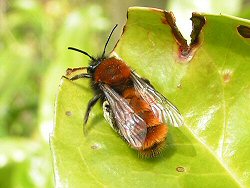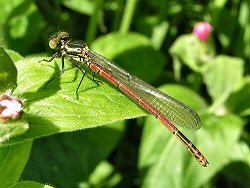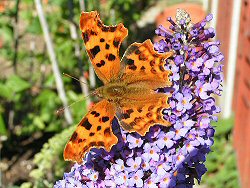| Features: Wildlife Trust Articles |  |
Biodiversity and the gardener
The word biodiversity was only coined in 1986 - reputedly by the American biologist Edward Wilson - by contracting the term 'biological diversity'.
 A female lawn bee (Andrena fulva) on cherry laurel (Prunus laurocerasus).
A mere twenty years later the word has become common currency and is embodied in the environmental policies of literally hundreds of nations. There is no single accepted definition, but in general, biodiversity is thought of as a relative measure of the diversity of living organisms in a given space. A female lawn bee (Andrena fulva) on cherry laurel (Prunus laurocerasus).
A mere twenty years later the word has become common currency and is embodied in the environmental policies of literally hundreds of nations. There is no single accepted definition, but in general, biodiversity is thought of as a relative measure of the diversity of living organisms in a given space.
Why has the word become so widely used? It's all due to the alarming rate at which animals and plant species are becoming extinct.  Biologists all over the world recognise that extinctions have dramatically increased over the last few hundred years Biologists all over the world recognise that extinctions have dramatically increased over the last few hundred years Biologists all over the world recognise that extinctions have dramatically increased over the last few hundred years. For example, of 129 known bird extinctions, 103 have occurred since 1800. The World Conservation Union estimates that there are in excess of 15,000 species currently under threat of extinction. More species are thought to become extinct every year now than at any other time during the short period of human existence on earth. By measuring, monitoring and promoting biodiversity, conservationists and governments hope to halt that trend. Biologists all over the world recognise that extinctions have dramatically increased over the last few hundred years. For example, of 129 known bird extinctions, 103 have occurred since 1800. The World Conservation Union estimates that there are in excess of 15,000 species currently under threat of extinction. More species are thought to become extinct every year now than at any other time during the short period of human existence on earth. By measuring, monitoring and promoting biodiversity, conservationists and governments hope to halt that trend.
Enjoying garden biodiversity
Declining biodiversity in the wider environment should not be seen as a remote problem for us gardeners: gardens are microcosms of the wider environment and declining biodiversity affects them too.
 A female large red damselfly (Pyrrhosoma nymphula).
By introducing many plants and structures, A female large red damselfly (Pyrrhosoma nymphula).
By introducing many plants and structures,  gardeners boost floristic and structural diversity, resulting in gardens being amongst the most biodiverse habitats on earth gardeners boost floristic and structural diversity, resulting in gardens being amongst the most biodiverse habitats on earth gardeners boost floristic and structural diversity, resulting in gardens being amongst the most biodiverse habitats on earth. But atmospheric pollution, climate change and other environmental problems take their toll in the garden just like anywhere else. gardeners boost floristic and structural diversity, resulting in gardens being amongst the most biodiverse habitats on earth. But atmospheric pollution, climate change and other environmental problems take their toll in the garden just like anywhere else.
To really enjoy garden biodiversity, it helps to look at things on a different scale: most wild animals in the garden are quite small. In the UK, there are around 400 species of birds, 50 mammals, 6 reptiles, 6 amphibians, and...wait for it...around 22,000 species of insects! Even flowering plants are outnumbered 15 to one by insects.
 Learning to love the diversity of invertebrates can really boost your enjoyment and appreciation of the garden Learning to love the diversity of invertebrates can really boost your enjoyment and appreciation of the garden Learning to love the diversity of invertebrates can really boost your enjoyment and appreciation of the garden. Many insects, for example butterflies, moths, dragonflies, damselflies and hoverflies, are undeniably beautiful, though all too frequently overlooked. Their small size is a problem, but by 'tuning in' to their world and looking at the garden on a different scale, you can learn to find and recognise lots of species in a surprisingly short space of time. There are many books and field-guides available to help you get even more pleasure from your garden safaris. If you have the patience, you can also find a lot of good information on the web to help you identify the insects you see. Learning to love the diversity of invertebrates can really boost your enjoyment and appreciation of the garden. Many insects, for example butterflies, moths, dragonflies, damselflies and hoverflies, are undeniably beautiful, though all too frequently overlooked. Their small size is a problem, but by 'tuning in' to their world and looking at the garden on a different scale, you can learn to find and recognise lots of species in a surprisingly short space of time. There are many books and field-guides available to help you get even more pleasure from your garden safaris. If you have the patience, you can also find a lot of good information on the web to help you identify the insects you see.
Thinking globally and acting locally
Although gardens are generally very biodiverse, gardeners should not rest on their laurels! There are many simple steps we can take to boost biodiversity even further in the garden.
 Hawthorn blossom (Crataegus monogyna): this native shrub provides shelter and sustenance to hundreds of species of animals. Hawthorn blossom (Crataegus monogyna): this native shrub provides shelter and sustenance to hundreds of species of animals. The kinds of plants we choose can have a profound influence on biodiversity The kinds of plants we choose can have a profound influence on biodiversity The kinds of plants we choose can have a profound influence on biodiversity. A diverse range of plants will, in general, lead to a diverse range of visiting animals, but there are other important guidelines to bear in mind when planting. The kinds of plants we choose can have a profound influence on biodiversity. A diverse range of plants will, in general, lead to a diverse range of visiting animals, but there are other important guidelines to bear in mind when planting.
- Flowers with flat-topped umbels or daisy-like heads are particularly attractive to many nectar-seeking insects.
- Flowers with complex flowers (e.g. double flowers) can make nectar inaccessible to insects.
- Sterile flowers (e.g. Hydrangea) are of limited use in the wildlife garden.
- Plant flowers in large blocks of colour to attract poorly sighted insects like butterflies.
- There's no need limit yourself to native plants, especially in the nectar border, but be sure to choose some natives, particularly shrubs and trees, which are associated with thousands of insects and other animals.
- Plant for cover as well as appearance: a good thorny hedge or ivy-covered wall will give protection to many nesting birds and other animals.
- Avoid using plants that are known to cause problems in the wider environment, e.g. Spanish bluebells (Hyacinthoides hispanica), Japanese knotweed (Fallopia japonica), parrot's feather (Myriophyllum aquaticum) and New Zealand pygmy weed (Crassula helmsii).
- Don't use peat-based mediums when planting - there is little point in boosting your garden's biodiversity at the same time as denuding that of the wider environment.
- Don't use plants that are not viable in the prevailing conditions in your area. If you live in a dry part of the country, it does not make sense to use high-maintenance moisture-loving plants.
As well as being thoughtful about how we stock our garden with plants, there are many other ways in which we can boost garden biodiversity.
- Provide animals with water. Even installing a birdbath will have a very noticeable effect; but if you can go the whole way and provide a pond, you will notice a big difference.
 A comma butterfly (Polygonia c-album) on buddleia (Buddleja davidii). A comma butterfly (Polygonia c-album) on buddleia (Buddleja davidii).- Create 'habitat piles'. These can be piles of logs, stones and rubble, cuttings, hollow stems and canes, or just about anything else. As long as they are left undisturbed, they will attract myriad invertebrates and other small animals.
- A compost heap is, in one sense, just another kind of habitat pile. However compost heaps also have unique characteristics (e.g. they generate heat) that make them extremely productive micro-habitats in the garden. They also benefit the wider environment because it's a direct way of recycling vegetable waste.
- Provide nest boxes. Bird nest boxes are a classic way of attracting birds to the garden, but nowadays the concept has been widened to include many other animals. You can buy (or often make quite simply) nesting or shelter boxes for hedgehogs, bats, solitary bees, bumblebees, ladybirds, lacewings and many other insects. Very often, the shelters you put up will be used in unexpected ways; for example bumblebees sometimes use nest boxes intended for birds.
What you do in your garden is just as important as what you put in it. Your garden, and the wider environment, will benefit if you follow a few simple principles.
- Cultivate a relaxed attitude towards your garden. Don't let natural opportunists like 'weeds' provoke you to battle stations every time they appear. You may find that certain parts of your garden benefit from their presence.
- Think imaginatively: don't be constrained by the 'received wisdom' of gardening that often amounts to nothing more than a collection of stale ideas and prejudices.
- Delay the autumn tidy-up until the following spring. The over-tidy winter garden sustains much less life than one where the main tidy up is done just before the onset of the growing season.
- Don't use pesticides. A well-balanced natural community of insects, animals and plants does not need chemical inputs. Indeed it is often the addition of chemicals to a system that upsets the natural balance and, in the long run, leads to explosions of pests.
 we already know that gardens are important on a national scale for animals like frogs (Rana temporaria) and song thrushes (Turdus philomelos) we already know that gardens are important on a national scale for animals like frogs (Rana temporaria) and song thrushes (Turdus philomelos) By following a few rules of thumb, we can boost biodiversity in our gardens without contributing further to its decline in the wider environment. Don't think for a minute that our local contributions are unimportant: we already know that gardens are important on a national scale for animals like frogs (Rana temporaria) and song thrushes (Turdus philomelos). There are likely to be hundreds of other, less noticeable, animals and plants that also depend on them to a great extent. By following a few rules of thumb, we can boost biodiversity in our gardens without contributing further to its decline in the wider environment. Don't think for a minute that our local contributions are unimportant: we already know that gardens are important on a national scale for animals like frogs (Rana temporaria) and song thrushes (Turdus philomelos). There are likely to be hundreds of other, less noticeable, animals and plants that also depend on them to a great extent.
| First published March 2005. | |
Copyright Richard Burkmar. Permission is hereby granted for anyone to use this article for non-commercial purposes which are of benefit to the natural environment as long the original author is credited. School pupils, students, teachers and educators are invited to use the article freely. Use for commercial purposes is prohibited unless permission is obtained from the copyright holder. |
Back to home page
Do you live in Merseyside? Interested in its wildlife? | |